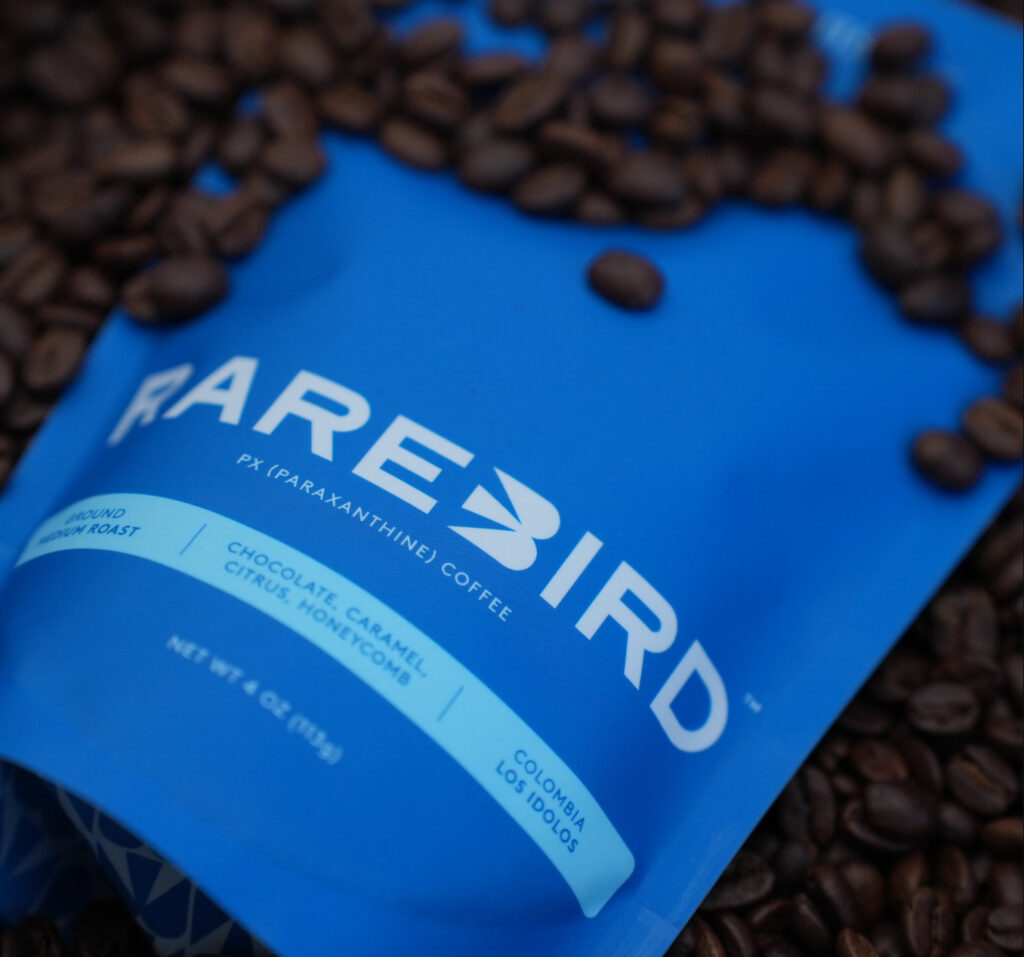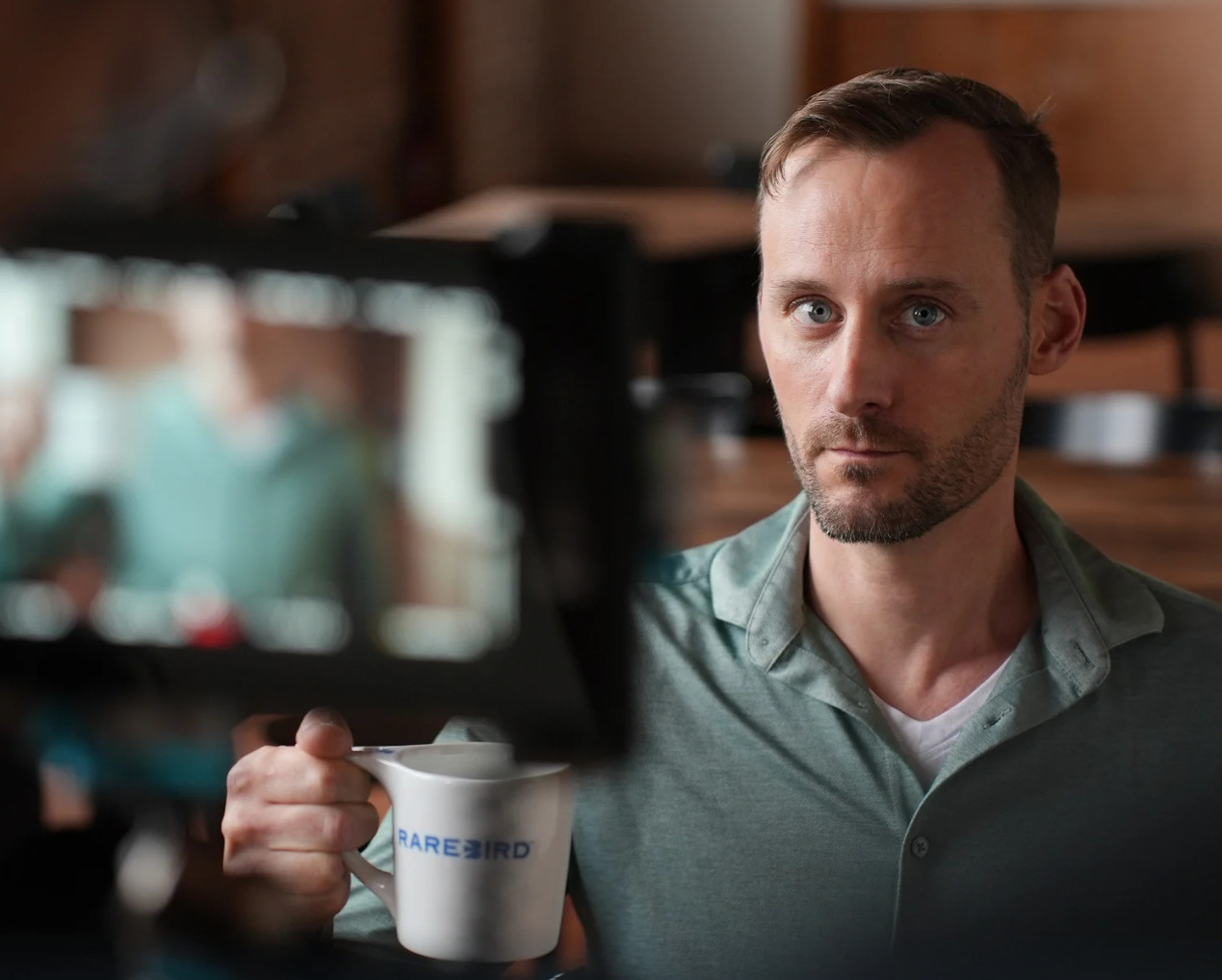[Disclosure: AgFunderNews’ parent company, AgFunder, is an investor in Rarebird]
For coffee drinkers that want the instant stimulation caffeine delivers but not the associated jitters, sleeplessness and anxiety, decaf doesn’t really hit the spot, says Dr. Jeffrey Dietrich.
“I started drinking coffee as an undergraduate with no negative side effects. But over time I had to cut down to one cup a day. I tried decaf for a while, but it didn’t give me what I wanted. So I started diving into the literature on caffeine and came across paraxanthine (PX).”
A metabolite of caffeine that is now being targeted at energy drinks, pre-workout supplements and other products, paraxanthine delivers what most people want from energizing beverages, says Dietrich: stimulation without the nasty side effects.
Founded in 2020, Rarebird coffee combines Colombian decaf coffee and PX to deliver just that, claims Dietrich (JD), who caught up with AgFunderNews (AFN) to discuss coffee, stimulants, and his ultimate goal: “I want you to walk into every Starbucks and have this coffee.”
AFN: What made you leave the company (Lygos) you cofounded to start a new company?
JD: I was at Lygos (a biotech company seeking to replace petroleum-derived chemicals with bio-based alternatives) for almost 10 years and it was very fulfilling work, but it’s a really tough space for a startup as it’s all about massive economies of scale. So I began thinking about what to do next.
AFN: What was on the market and in the literature on PX when you first started researching it?
JD: When I first started looking at PX, Ingenious Ingredients [now Enfinity Energy – which is targeting the dietary supplements market with PX and has funded small-scale clinical studies into its cognitive benefits] had not gone public with a lot of what they were working on, but there was a body of literature out there, so I went through it and started to piece it all together.
On top of that, we started contracting our own studies on PX with independent labs, in vitro studies, and in vivo studies [on rats], as well as getting consumer feedback. But there is now a body of evidence that shows that for most people, PX is going to be a far better solution than caffeine.
AFN: Why is PX a better solution than caffeine, given that caffeine is metabolized into PX anyway?
JD: One problem with caffeine is that it has a relatively long half-life, which varies a lot between people. So there are fast metabolizers where the half-life might be three or four hours and there are slow metabolizers where the half-life might be six to eight hours, which can negatively impact sleep quality.
There’s also evidence that shows there are genetic SNPs [single nucleotide polymorphisms or genetic variants] within receptors in the brain that are strongly correlated with an anxiety response to caffeine. If anyone has enough caffeine, it will eventually trigger the body’s fight and flight response. But if you have these SNPs which are in a good portion of the population, you’ll get this reaction with lower amounts of caffeine.
AFN: Rather than adding PX to decaffeinated beans, can you add enzymes to regular beans to convert the caffeine to PX?
JD: Theoretically, yes. But there are reasons why that won’t work economically as these enzymes don’t work great unless you’re in a controlled production environment, so it would be quite challenging to use them on green coffee beans. So instead, we’re starting with decaffeinated coffee and that allows us to get to market as quickly as possible.
Long term, I can absolutely envision different ways that you can implement this technology so that you get a whole bean product that doesn’t require the decaffeination or some of the other steps that we have to do today.
AFN: PX can be produced via chemical synthesis, the enzymatic conversion of caffeine (using the same enzymes the liver uses in the body), or microbial fermentation. What’s the best approach?
JD: The only place that one sees PX in large quantities in nature is within the human body by virtue of our caffeine consumption, so you’re never going to be able to find a natural source you can just isolate and use without some kind of major plant engineering project. So that means you’re left with biological or synthetic routes.
Both will work, but this is one of those rare instances where a biological process, an enzyme-catalyzed process will be much, much lower cost than a synthetic process. And that’s really the long term vision we have, to be the lowest cost producer of PX but also to have patents on the coffee featuring PX.
AFN: So which approach is Rarebird taking to produce PX?
JD: As a short-term stopgap we’re using a synthetic process to make PX but we have a National Science Foundation grant that’s funding the development of a highly scalable biological process [ie. using enzymes to break down caffeine into PX]. But we’re not speaking publicly about this because we have some IP that hasn’t published yet.
AFN: So once you’ve got the PX, how do you get it into the coffee?
JD: Our coffee has 60 milligrams PX per serving. Again, I can’t get into the details of the production process because of IP considerations, but what I can say is that right now we infuse roasted ground coffee with PX. We have also developed technology to do it pre-roast with green coffee beans, which would give us the option of selling whole bean PX coffee, but it’s not quite ready for prime time. That might be a couple of years from now.

AFN: What’s the regulatory status of PX?
JD: When we started the company, PX was not yet approved for use in foods or supplements for that matter. So we and then independently Ingenious Ingredients conducted the studies required by the FDA to achieve GRAS (generally recognized as safe) status. We completed that [self-GRAS] process in 2022.
AFN: Do you plan to submit that GRAS determination to the FDA?
JD: It’s not on the immediate time horizon, but certainly it’s something I think, is important, because really, what we’ve seen is that PX has substantially better performance on these safety tests than caffeine.
There are issues with caffeine and I’d like to think that 10 years from now, we’ll be at the point where the FDA will say there are problems with caffeine especially from a mental health and sleep perspective and there is something better out there and that’s PX.
AFN: What’s the go to market strategy for your coffee?
JD: My goal is for PX to be the third coffee, so you’ve got regular coffee, decaf coffee, and PX. I don’t know what percentage of the population is going to switch to PX if you go out 10, 20, 30 years, but I think it’s going to be a big chunk, and I want this coffee to be every single coffee shop.
That obviously is a big vision, and it’s going to take time to get there. So the first step was to launch a direct to consumer business, build a subscriber base, and really understand how people are using the product. Are people drinking it in the afternoons because it’s less likely to negatively affect sleep?
The great thing about this direct consumer feedback is that things popped up that we didn’t anticipate, so as an example, a lot of people said they had gastrointestinal issues with caffeinated coffee and it looks like PX doesn’t cause those. It’s anecdotal, and we’re not going to make any claims about it, but that’s the kind of information you don’t get from looking at the scientific literature.
The next step is to go into independent coffee shops and cafes and then regional chains.
AFN: What’s the core message to the consumer?
JD: That PX coffee is coffee, but it’s better, right? You’re going to feel better during the day and sleep better at night. You’re not going to feel jittery, wired, and over-caffeinated. We can go into the reasons as a second layer of explanation. Longer term the plan is to collect more clinical data that will support qualified health claims.
But it also has to be great tasting coffee. So we’ve been working with Major Cohen, who worked at Starbucks for 25 years and lives and breathes coffee. He has been helping us craft a product and experience that meets consumer expectations in the first second, and then PX does the talking later.
AFN: How have you funded the business?
JD: We first went through Y Combinator in the summer of 2020. Since then I’ve raised some capital via safe notes and we did a seed round this summer co-led by AgFunder. We did a Kickstarter program because it was a good way to start getting pre orders for the coffee as we looked at launch, and a good way to get our messaging out.
AFN: What progress have you made so far?
JD: We started shipping in February 2023 and in August, we launched an $18 per bag subscription scheme for 12oz bags. Then roughly three weeks after someone makes an initial purchase, we send them a survey and if they complete it they get an Amazon gift card.
So far, 92% of people who’ve tried the coffee say they feel better drinking PX coffee vs caffeinated coffee. And three quarters are drinking PX coffee in the afternoon, which is substantially higher than the figures for caffeinated coffee. Two thirds say their sleep quality is improved. So the consumer response is really validating what the science says. We’ve also got good repeat rates.

AFN: What IP do you have and how critical will this be to the future of the business?
JD: You can’t patent PX itself, but we have a patent pending on PX coffee as well as the methods to make it, and we anticipate that patent will come through within the next couple of months.
If we get that, it would be a case of, if you’re going to have PX coffee, you need to work with Rarebird. That’s a really important moat for us. If we get the claims we’re going for, no one would be able to produce a PX coffee without infringing on that IP. We’re also filing IP around multiple production methods for PX.
AFN: What about other applications for PX such as energy drinks?
JD: You can use PX anywhere that caffeine is used today, but we’re focused on coffee for now. In future we may look towards partnering with other companies to bring PX into other form factors.
AFN: What’s your manufacturing and scale up plan?
JD: We work with contract manufacturers for the production of PX and we do the PX infusion ourselves to make sure we really understand the process. Now that we’ve done that, we will be able to take that know-how to a contract manufacturer for larger scale production.
AFN: Have any big coffee companies expressed an interest in what you’re doing?
JD: We are speaking to a number of big coffee companies and other companies that currently use caffeine in their products.




